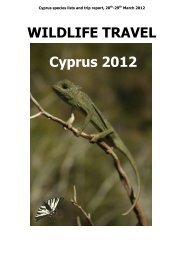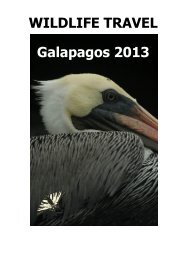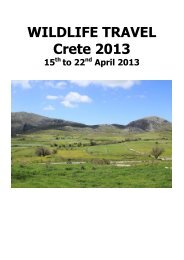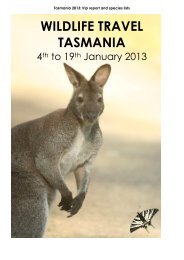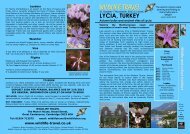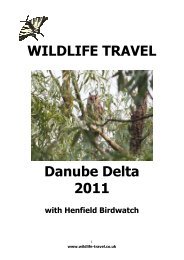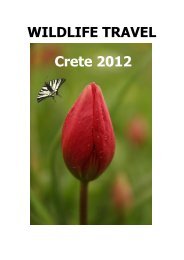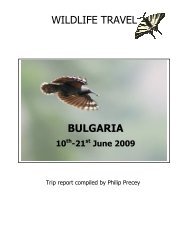holidays
guyana - Wildlife Travel
guyana - Wildlife Travel
- No tags were found...
You also want an ePaper? Increase the reach of your titles
YUMPU automatically turns print PDFs into web optimized ePapers that Google loves.
Wildlife and culture <strong>holidays</strong><br />
WILDLIFE TRAVEL<br />
21st March-4th April 2014 (15 days)<br />
GUYANA<br />
Neotropical rainforest spectacular<br />
NEW FOR 2014<br />
in partnership with<br />
Sussex<br />
Wildlife Trust<br />
An exciting tour of Guyana, a wonderful place<br />
for wildlife with 80% intact rainforest.<br />
This trip will explore rainforest and savannah to provide a<br />
spectacular variety of wildlife. We will visit the wonderful<br />
Kaieteur Falls, the longest single drop of any waterfall in<br />
the world and enjoy a tour of the capital Georgetown to<br />
see the distinctive wooden colonial style buildings that<br />
give the city its unique character.<br />
During the trip we will find a wealth of birds to see<br />
including parrots, toucans, hummingbirds such as the<br />
beautiful crimson topaz and perhaps the magnificent harpy<br />
eagle. Mammals that we can hope to come across include<br />
howler and spider monkeys, white-lipped peccaries, giant<br />
river otter and giant anteater. Out in the savannah area<br />
we will take a boat trip at dusk to see the flowering of the<br />
giant Victorian water lily.<br />
Price<br />
£4795<br />
Single Room<br />
Supplement<br />
£350 (see note)<br />
Full board<br />
We will spend time at the Iwokrama Research Station,<br />
which sits at the centre of a million acres of rainforest;<br />
Surama community lodge which is run by the Macushi<br />
Tribe; and Karanambu Ranch, the home of Diana McTurk<br />
who has done much to protect and rehabilitate giant river<br />
otters in Guyana.<br />
This holiday offer the opportunity to visit one of the last<br />
great wilderness areas on the planet. The infrastructure<br />
is not so developed as other South American countries and<br />
away from the coastal area there are few roads so<br />
transport is often by boat and small plane. Where we<br />
travel by vehicle the roads are mainly tracks. The<br />
accommodation is basic but clean, the food is excellent<br />
and the people are wonderful. A spirit of adventure will<br />
be well rewarded.<br />
Day 1 flight to Georgetown<br />
Day 2 Caribbean coast<br />
Day 3 Georgetown<br />
Day 4/5 Karanambu Ranch<br />
Day 6 Rupununi Savannah<br />
Day 7/8 Iworkrama Rainforest<br />
Day 9/10 Atta Rainforest Lodge<br />
Day 11 Surama<br />
Day 12 Burro Burro River<br />
Day 13 Kaieteur Falls<br />
Day 14 leave Guyana<br />
Asa Wright, Trinidad<br />
Day 15 return to UK<br />
Leaders<br />
Mike Russell<br />
and local guides<br />
Kaieteur Falls,<br />
spectacular rainforest<br />
All our<br />
profits<br />
are<br />
donated<br />
to<br />
The<br />
Wildlife<br />
Trusts
ITINERARY<br />
Please note that the itinerary may be changed to suit the weather or other<br />
practicalities or at the discretion of the leaders.<br />
On most days there will be pre-breakfast and dawn walks as this is the best time to view<br />
wildlife. These will be optional when we return to the lodge for breakfast, which is<br />
most days. Only when we move onto other accommodation before breakfast will everyone<br />
need to leave at dawn.<br />
Day 1 Friday 21st March Flight from UK to Guyana. o/n Cara Lodge, Georgetown.<br />
Day 2 Saturday 22nd March After a leisurely breakfast and introduction to our holiday,<br />
we will travel eastward from Georgetown and along the coast to the Mahiaca River. We<br />
will take a boat on the river to see Guyana’s national bird the Hoatzin, which is found in<br />
abundance along this river system. On our return journey to Georgetown, we will visit some<br />
mudflats where we are likely to find a range of waders making their way northwards as well<br />
as Scarlet Ibis, Black Skimmer, Brown Pelican and Magnificent Frigatebird. We may also<br />
visit a heronry where Black-crowned and Yellow-crowned Night-herons, Little Blue Herons<br />
and various egrets nest. o/n Cara Lodge.<br />
Day 3 Sunday 23rd March This morning we will see dawn rise over the extensive and<br />
beautiful Botanic Garden where, if we are lucky, we may see the Blood-coloured<br />
Woodpecker, an astonishingly colorful Veniliornis found only in the Guianas and even here<br />
almost wholly limited to this narrow coastal plain. The gardens host Red-bellied and Redshouldered<br />
Macaws and a host of parrots including Orange-winged, Yellow-crowned and<br />
Festive Parrots. We will walk on trails in the back on the gardens, enjoying our introduction<br />
to the birds of Guyana. This afternoon we will enjoy tour of the city, learning more about<br />
the local history and culture. o/n Cara Lodge<br />
Day 4 Monday 24th March After an early breakfast we transfer to the airport at nearby<br />
Ogle, where Red-breasted Blackbirds sing and Snail Kites patrol and from where we fly by<br />
small 15-seater aircraft to Karanambu Ranch, the home of Diane McTurk, widely known for<br />
her work rehabilitating orphaned Giant Otters. During our stay at Karanambu, we will<br />
make a special effort to locate one of the oddest-looking members of the cotinga family,<br />
the Capuchinbird. There are at least two leks relatively close to our lodge and we plan to<br />
visit at least one of these display areas, where we should get great looks as the males seek<br />
to attract females with their weird, almost cow-like, song.<br />
This afternoon we travel by boat to look for wild Giant Otters and as dusk falls to the ponds<br />
to see the giant waterlily bloom at dusk. On the return trip we will spotlight for Black<br />
Caiman. o/n Karanambu Ranch.<br />
2
Day 5 Tuesday 25th March Today we will take a morning excursion out into the<br />
savannah with vaqueros (the local cowboys) to look for Giant Anteater. During this<br />
excursion we will also bird on the savannah and around ponds and hope to find the<br />
Bearded Tachuri, a member of the flycatcher family which has declined markedly in<br />
recent years as it requires fairly undisturbed savannah grasslands. Tonight we will also<br />
head out onto the savannahs after dark to look for night birds: on a good evening it is<br />
possible to see six species of nightjar and nighthawk, as well as Double-striped Thick-knee.<br />
o/n at Karanambu Ranch.<br />
Day 6 Wednesday 26th March After a final morning of birding around Karanambu, We<br />
then transfer slowly along the Rupununi River keeping an eye out for Wood Stork, Bat<br />
Falcon and King Vulture. The trip should give us an excellent opportunity to look for various<br />
river-edge, wetland and open country species and we stand a good chance of seeing<br />
Black-bellied Whistling-Duck, Green Ibis and the charismatic Swallow-wing. Depending on<br />
the river level, this trip offers an excellent opportunity to look for Giant Otters as there are<br />
several family groups which live along this stretch of the Rupununi River. Both Black and<br />
Spectacled Caimans inhabit the river and several species of monkey including Red Howler,<br />
White-faced Saki and Squirrel Monkey can be found in the riverside trees.<br />
The journey ends at Ginep Landing, where we travel to Annai, the northernmost community<br />
of Rupununi. The Rupununi Savannah is to Guyana what the Gran Sabana is to<br />
Venezuela, an extensive area of grassland with termite mounds and scattered or riparian<br />
woodland. It differs in that much of it is devoted to cattle raising, though the large ranches<br />
are not very productive. Indeed, one can travel for hours without seeing a domestic animal<br />
of any sort.<br />
Needless to say, the birdlife here is markedly different from that of the rainforest. In the<br />
grasslands and nearby forested hills, we look for Double-striped Thick-knee, Green-tailed<br />
Jacamar, Finsch’s Euphonia, Fork-tailed Flycatchers, Savannah and Black-collared Hawks.<br />
The resort with its tropical gardens and flowering trees, resembles an oasis in the<br />
savannah, and attracts many species of birds, particularly nectar feeders and frugivores.<br />
Amazonian Troupial, Amethyst Woodstar, White-chinned Sapphire, Long-billed Starthroat<br />
and several Hermits patrol around the grounds. Nearby forest patches are home to<br />
Amazonian Scrub Flycatcher, Rufous-browed Peppershrike and a variety of antbirds. o/n<br />
Rock View Lodge.<br />
Day 7 Thursday 27th March After some pre-breakfast birding along the foothills of the<br />
Pakaraima Mountains, we transfer by vehicle to Iwokrama River Lodge. The Iwokrama<br />
Rainforest is a vast wilderness of one million acres. This protected area was<br />
established in 1996 as the Iwokrama International Centre for Rainforest Conservation and<br />
Development.<br />
Iwokrama is in the heart of one of four last untouched tropical forests of the world - the<br />
Guiana Shield of north-eastern South America. Iwokrama was established as a protected<br />
area with a difference - the full involvement of the local people. Iwokrama is exceptional<br />
among conservation organizations because it joins with local people in every aspect of its<br />
work. From research to business, Iwokrama ensures local economic and social benefits<br />
from forest use and conservation.<br />
The Forest is in the homeland of the Makushi people, who have lived here and used the<br />
forest for thousands of years. The success of Iwokrama relies on the ownership of local<br />
people and the combined skills of specialists and communities. Iwokrama does what so<br />
many international conventions have acknowledged as best practice. It has begun<br />
conservation locally and integrated conservation into national development.<br />
The trails close to the Iwokrama Field Station are amazingly rich in birdlife, including some<br />
true specialities of the Guianas: the aptly named Guianan Toucanet and Guianan Red<br />
Cotinga as well as Green Aracari, Todd’s Antwren and Tiny Tyrant Manakin are just some of<br />
the birds that may hope to find during our excursions which are restricted to this corner of<br />
the continent. 3
After dark, we’ll set out on the river once more, in hopes of finding one or another of its<br />
four species of caiman, and listen for nightbirds such as Spectacled Owl, Rufous Potoo,<br />
Zigzag Heron or Blackish Nightjar. If luck is on our side, our paths may cross with those of<br />
some mammals, perhaps even a Puma or Capybara. o/n Iwokrama River Lodge<br />
Day 8 Friday 28th March After an early breakfast we set out by boat: a 30 minute<br />
journey takes us to the foot of Turtle Mountain. Here we explore the trails for a few hours<br />
first visiting Turtle Ponds where Rufescent Tiger-Heron, Sunbittern and Sungrebe hunt. We<br />
will continue through the forest, looking for Red Fan Parrot, Red-throated Caracara, Doubletoothed<br />
Kite, White-plumed and Ferruginous-backed Antbird and Royal Flycatcher along the<br />
way. Climbing to an elevation of 900 feet, we get a view of the forest canopy below and<br />
chances of Green Aracari, White Bellbird or a fly-by of one of five types of eagles known<br />
from the forests. This trail is also a great location for seeing Black Spider Monkey and<br />
Red Howler Monkey.<br />
After lunch back at the lodge, a ranger will give us a brief overview of Iwokrama and the<br />
work they are conducting along with a tour of the facilities. Mid afternoon we will travel<br />
along the road through the heart of the Iwokrama Forest, where there is a good chance to<br />
see the elusive Jaguar. The Iwokrama forest is rapidly gaining an international reputation<br />
for its healthy jaguar populations that seem not to be troubled by the appearance of curious<br />
humans. No promises, but many have been lucky!<br />
Along the road, we will watch for the myriad of bird species that frequent the forest edge,<br />
including Crimson and Purple-necked Fruit-crow, Crimson Topaz, Green Oropendula, Scarlet<br />
and Red-and-Green Macaw, Blue-cheeked and Orange-winged Parrot and the entertaining<br />
Gray-winged Trumpeter. We will stop at a location know as 27-mile stretch and sit on a hill<br />
with a view down the road for about 1000 meters and hope our patience is rewarded with a<br />
Jaguar sighting. After dark we will spotlight along the road for not only Jaguar but other<br />
wildlife and night bird opportunities. o/n at the Iwokrama River Lodge.<br />
Day 9 Saturday 29th March Today we transfer to our next lodge. Along the way we will<br />
enjoy yet more excellent birding, including a locality known as Mori Scrub, characterized by<br />
an unusual low, sandy forest. Our target birds here will include Guianan Red-Cotinga, Black<br />
Manakin, Rufous-crowned Elaenia and Yellow-throated Flycatcher.<br />
The journey continues by 4x4 Bedford Truck to the Iwokrama Canopy Walkway.<br />
Although the forest around Atta Rainforest Lodge is excellent for birds, the major attraction<br />
here is a 154 metre long canopy walkway which is only 750m from the lodge. The walkway<br />
has four platforms, the highest of which is over 30 metres above the ground, and these will<br />
allow us to get great looks at a range of canopy species, many of which we would struggle<br />
to see well from the forest floor. Amongst the likely highlights are Painted, Brown-throated<br />
and Golden-winged Parakeets, Caica Parrot, Guianan Puffbird, Waved and Golden-collared<br />
Woodpeckers and Spot-tailed, Todd’s and Ash-winged Antwrens. The walkway is also an<br />
excellent place to look for various species of cotinga including the poorly known and rangerestricted<br />
Dusky Purpletuft and if there are any suitable fruiting trees nearby, we stand a<br />
good chance of seeing this bird, as well as the more widespread Purple-breasted Cotinga.<br />
Another area where we will want to spend some time is the clearing around the lodge, as<br />
this is one of the best places to see another of Guyana’s “must see” birds, the Crimson<br />
Fruitcrow. This species is seen here on a reasonably regular basis, as it often comes to<br />
feed in some of the nearby trees. The clearing is also a reliable site for Black Curassow as<br />
there is a family party which has become habituated to people and regularly passes through<br />
the clearing. With reasonable luck, we should be able to add this bird to the impressive list<br />
of species we hope to see around the lodge and walkway. o/n Atta Rainforest Lodge.<br />
Day 10 Sunday 30th March Today we will use the walkway and trails to look for other<br />
species including Spix’s and Marail Guans, Grey-winged Trumpeter, Red-fan Parrot, Eastern<br />
Long-tailed Hermit, Crimson Topaz, Great and Paradise Jacamars, Guianan and Pied<br />
4
Puffbirds, Red-billed Woodcreeper, Black-throated<br />
Antshrike, Guianan Streaked Antwren, Guianan<br />
Warbling Antbird, Pompadour Cotinga, Purplethroated<br />
Fruitcrow, Helmeted Pygmy-Tyrant, Golden<br />
-sided Euphonia and both Red-and-Black and Yellow<br />
-green Grosbeaks. After lunch you will learn about<br />
the unique business model of Community and<br />
Tourism Services who manage the walkway and<br />
lodge on behalf of Iwokrama. The trails also have an<br />
interpretative walk with the trees named and you<br />
can learn about their varied uses in the Macushi<br />
culture. Another of our major targets will be the<br />
poorly known White-winged Potoo which, after<br />
dark, can be found both around the lodge and at the<br />
walkway. Locating this bird will be one of our major<br />
priorities but we will need a bright moon-lit night to<br />
stand a reasonable chance of seeing it. o/n Atta<br />
Rainforest Lodge.<br />
Day 11 Monday 31st March For those who chose,<br />
we will welcome the dawn chorus from the canopy<br />
walkway: Short-tailed Nighthawks settle in for the<br />
day, swifts take to the sky, White throated and<br />
Channel-billed Toucans yodel, and Barred Forest<br />
Falcons call as the sun rises over the rainforest…<br />
magical!<br />
After breakfast we will travel through the heart of<br />
the Iwokrama Forest. Along the road, we will stop at<br />
the Cock-of-the-rock Trail, an easy 20 minute walk,<br />
to hopefully have our first view of the Guianan<br />
Cock-of-the-rock. The highlights come thick and<br />
fast today, as we next visit a nearby Harpy Eagle<br />
nest. The nest itself is located in a huge emergent<br />
tree only a couple of miles from the village and if we<br />
are extremely fortunate, we may see one of the<br />
adult birds bringing a sloth or monkey to the nest to<br />
feed their chick. The trek into the nest site is about<br />
an hour each way on a reasonable trail.<br />
The journey continues by road to the Amerindian<br />
community of Surama. The village is set in five<br />
square miles of savannah and surrounded by the<br />
densely forested Pakaraima Mountains. Surama’s<br />
inhabitants are mainly from the Macushi tribe and<br />
still observe many of the traditional practices of<br />
their forebears. If we have time, we will take a walk<br />
into the forest with an indigenous guide to learn<br />
about the medicinal plants and their uses in the<br />
Amerindian culture. Another of the special birds<br />
which can be found around Surama is the Rufouswinged<br />
Ground-cuckoo. Whilst Neomorphus groundcuckoos<br />
are undoubtedly amongst the toughest<br />
birds to locate anywhere in the Neotropics, we will<br />
use expert local guides to assist us. o/n Surama Eco<br />
-lodge.<br />
5
Day 12 Tuesday 1st April Before dawn we walk through the forest to the Burro Burro<br />
River for a quiet and skillfully guided paddle, hearing the voices of many birds singing in<br />
near darkness in the forest, and seeing many of them later when the light grows stronger.<br />
We’ll also search the banks for mammals: Capybara, Tayra or even Tapir may be<br />
encountered. Although the Harpy Eagle and Rufous-winged Ground-cuckoo may be the two<br />
star attractions at Surama, there are plenty of other species to look for and we will hope to<br />
encounter Red-legged Tinamou, Painted Parakeet, Dusky Parrot, Lilac-tailed Parrotlet, Palethroated<br />
Barbthroat, Rufous-throated Sapphire, Great and Paradise Jacamars, Blackspotted<br />
Barbet, Golden-spangled Piculet, Chestnut-rumped Woodcreeper, White-browed,<br />
White-bellied, Rufous-throated Antbirds, Helmeted Pygmy-Tyrant, Lemon-chested and Ashy<br />
-headed Greenlets and Finsch’s Euphonia. o/n Surama Eco-lodge.<br />
Day 13 Wednesday 2nd April One final chance, for those who want it, for some early<br />
morning birding around Surama. After breakfast back at Surama village, we will depart by<br />
4x4 for the nearby airstrip to join a chartered flight over the Demerara and Essequibo<br />
Rivers and hundreds of miles of unbroken tropical rainforest to Kaieteur, the world’s<br />
highest free-falling waterfall. Though Venezuela’s Angel Falls are greater in total height,<br />
their filamentous drop occurs by stages, whereas Kaieteur is a single, massive cataract 100<br />
metres wide as the Potaro River makes a sheer drop of 228 metres, nearly five times the<br />
height of Niagara. The spectacle is the more impressive for its remoteness and it is<br />
altogether possible that we’ll be the only people viewing it. Here we will hope to find Whitechinned<br />
and White-tipped Swifts swirling over the gorge and perhaps we’ll be lucky enough<br />
to see White-tailed Goldenthroat, Orange-breasted Falcon or Musician Wren. After our fill of<br />
the spectacular falls, we will continue on to Georgetown, where we will spend the rest of<br />
the afternoon relaxing around the lodge and preparing for our flights home. o/n Cara Lodge<br />
Day 14 Thursday 3rd April We transfer to the airport for our morning flight to Trinidad.<br />
Flight times permitting, here we will take a day visit to the renowned Asa Wright Nature<br />
Centre and Lodge. Over 170 bird species have been recorded at this former coffee, cocoa<br />
and citrus plantation situated in a valley in Trinidad’s northern mountain range. Natural<br />
secondary growth has festooned the abandoned plantation areas with vines and a host of<br />
epiphytes with the resultant effect of being deep in a tropical rainforest.<br />
Over lunch on the veranda, Orange-winged Parrots will be calling loudly, Purple<br />
Honeycreeper and Bananaquits will be everywhere and there are also Trinidad Squirrels,<br />
Agoutis and Giant Tegu lizards, while various tanagers and hummingbirds visit the feeders.<br />
Alas, all too soon our time will be up and will have to drag ourselves away and head back to<br />
the airport for our final flight back to the UK (arriving Day 15 Friday 4th April).<br />
6
Accommodation<br />
Accommodation at the lodges is clean and comfortable, with en-suite facilities and very good<br />
food: however, in comparison with lodges in more developed countries such as Costa Rica<br />
you should be prepared for the accommodation to be a little more basic. Iwokrama River<br />
Lodge has wooden lodges based around the grounds with a very comfortable restaurant<br />
and study area. Atta Rainforest Lodge is a small centre where the accommodation has<br />
been built in the last five years. Surama Eco-Lodge was built and is run by the Amerindian<br />
Community and you will stay in traditional round wooden lodges. Rock View Lodge was<br />
one of the first lodges to be built in Guyana and is more similar to those found in more<br />
developed South American eco tourist areas. Karanambu Lodge has wooden lodges with a<br />
lovely central area to eat and some very tempting hammocks! We start and end the holiday<br />
at Cara Lodge which is a lovely bright modern and comfortable hotel, in one of the oldest<br />
buildings in Georgetown. Single rooms are available at all lodges except possibly<br />
Karanambu (2 nights). The SRS does not take into account a single at this lodge. Single<br />
availability here will only be known when final group numbers are known and, if available,<br />
there may be an extra charge. Singles are limited at all other lodges too so please talk<br />
to us if you want a single room. We will discuss the options for sharing with you.<br />
Transport<br />
Away from the coast there is no developed road structure and there is only one track<br />
through the forest on which we travel, in a truck which has an open top so you can view<br />
wildlife while you travel. We also travel by boat. Some of the longer journeys are<br />
undertaken in small 5-13 seater planes (depending on group size) and this is the only way<br />
to get to the wonderful Kaieteur Falls. It is important to note that there will be strict<br />
weight restrictions on these planes of just 20lbs/9kg luggage per person which is<br />
strictly enforced. You MAY be able to pay for excess luggage (less than a dollar per<br />
pound), but WE CANNOT GUARANTEE THAT THEY WILL ALLOW THIS. You will also be<br />
required to let us know your body weight with clothing similar to that which you would<br />
expect to travel in on the flight, to pass on to the airline. Any excess luggage can be left<br />
securely in Georgetown with our Guyanan travel company.<br />
Fitness and health<br />
You need to have a reasonable level of general fitness to be able to participate in this<br />
holiday. Although most of the walks are not long you need to be comfortable to be out for 3-<br />
4 hours in tropical conditions and heat. The climb up to Turtle Mountain may be a little<br />
strenuous, although the view is worth it at the top! You should also feel comfortable about<br />
walking on a safe aerial walkway. Walking boots are recommended for all excursions.<br />
Malaria is present throughout Guyana. Anyone entering Guyana from an area where Yellow<br />
Fever is endemic requires a Yellow Fever vaccination certificate. Other ‘standard’ travel<br />
vaccinations to consider are tetanus, diphtheria, hepatitis A and B, typhoid, rabies and<br />
cholera. Dengue fever is present, and you should take precautions against mosquito bites<br />
during the daytime as well as at night. You should consult your GP or travel for travel health<br />
advice including anti-malarial prophylaxis AT LEAST EIGHT WEEKS before travelling.<br />
Please see the General Information leaflet for health and fitness requirements. We will be<br />
walking for at least some of each day, as well as taking excursions by safari vehicle. You<br />
need to be able to get in and out of small boats and planes comfortably and the<br />
holiday therefore is not suitable for people with significantly limited ability. This<br />
holiday offers a fantastic opportunity to see one of the last pristine rainforest areas in the<br />
world but a spirit of adventure is needed to take part. The weather and general nature of<br />
the country might involve changing plans and itineraries but anyone prepared to accept<br />
unforeseen situations will be rewarded with a truly memorable experience. Appropriate<br />
safety information and advice will be provided with final details and on the holiday.<br />
It is essential that, PRIOR TO BOOKING, you ring us to discuss any potential<br />
fitness or health problems that may affect you on this trip, 01954 713575.<br />
7
Leaders<br />
Mike Russell is a Director of Wildlife Travel and has worked for Sussex Wildlife Trust since<br />
1985, currently as Head of Adult Learning. With a life-long interest in birds he has sought to<br />
encourage and enthuse others to become involved in conservation. Mike has led many<br />
wildlife <strong>holidays</strong> for Wildlife Travel since 2001, including Costa Rica, Ecuador, Trinidad and<br />
the Pantanal. Mike visited Guyana in 2008 and has been planning this trip ever since!<br />
Weather<br />
We will be travelling in the 'dry' season and therefore should expect clear days with little<br />
rain. Temperatures are nearly constant all year, around 28-29C in the day and 22-24C at<br />
night. However, this is a tropical country, we may experience a mixture of weather<br />
conditions. We will adapt our itinerary to the weather as much as possible.<br />
Flights<br />
Group flight with Caribbean Airlines from London Gatwick, via Port of Spain, Trinidad.<br />
21st March BW903 Depart London Gatwick 11.50, arrive Port of Spain 17.50<br />
BW528 Depart Port of Spain 20.10, arrive Georgetown 21.35<br />
3rd April BW662 Depart Georgetown 10.15, arrive Port of Spain 11.25<br />
BW902 Depart Port of Spain 19.40, arrive London Gatwick 10.00 (4th)<br />
Guyana and Trinidad are both 5 hours behind UK time.<br />
Passports and Visas<br />
You must have a valid passport for this trip (valid for at least 6 months after the end of the<br />
holiday, with at least 2 blank pages). Visas are not required for holders of a UK passport<br />
(for up to 30 days in Guyana and 90 days in Trinidad). Please obtain further advice (prior to<br />
booking on the holiday) if you hold another type of passport or if you have reason to<br />
believe that you will have a problem gaining entry to Guyana or Trinidad.<br />
TO BOOK<br />
Contact us to check availability and reserve a place. Complete the Booking Form and send<br />
to Sunvil Holidays (CAA-ATOL Licence 808, ABTA V6218), our tour operator, with your<br />
deposit. All details about booking are given in the Booking Pack.<br />
DEPOSIT PER PERSON £1000, SECOND INSTALLMENT ON<br />
CONFIRMATION OF HOLIDAY £1500.<br />
BALANCE DUE BY 20/12/2013<br />
INCLUDED: Return flight from London Gatwick to Georgetown, Guyana. Local transport as<br />
specified in itinerary, including internal flights. Half day visit to Asa Wright Nature Centre,<br />
Trinidad (if time allows). 13 night’s accommodation, full board basis (breakfast, lunch and<br />
dinner). Entrance fees except during optional sightseeing. Services of leader and guides.<br />
NOT INCLUDED: Departure taxes (US$20 in Georgetown, US$17 in Port of Spain).<br />
Refreshments. Gratuities. Travel insurance.<br />
WILDLIFE TRAVEL<br />
The Manor House, Broad Street,<br />
Great Cambourne, Cambridge CB23 6DH<br />
Tel: 01954 713575<br />
email: wildlifetravel@wildlifebcn.org<br />
www.wildlife-travel.co.uk<br />
8<br />
Directors: Christine Donnelly, Brian Eversham, Philip Precey, Michael Russell, Dr Tim Upson<br />
Wildlife Travel Ltd. Reg. No 2237697; Sussex Wildlife Trust registered charity number 207005



